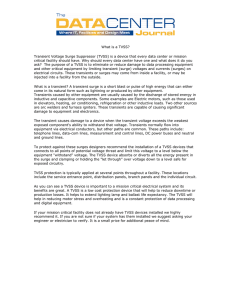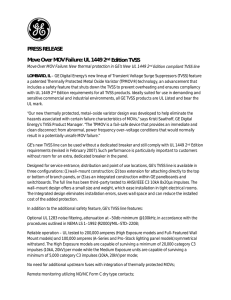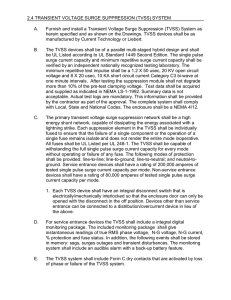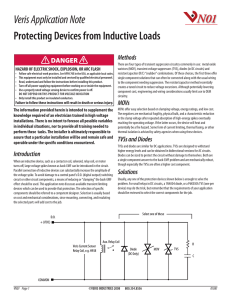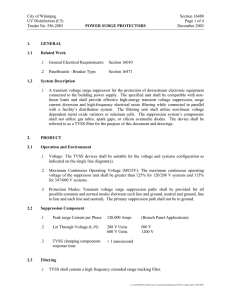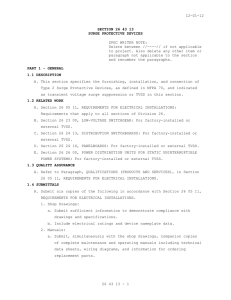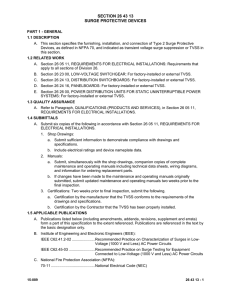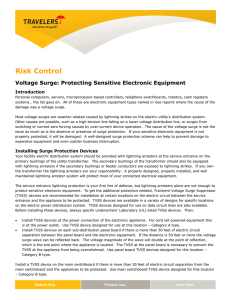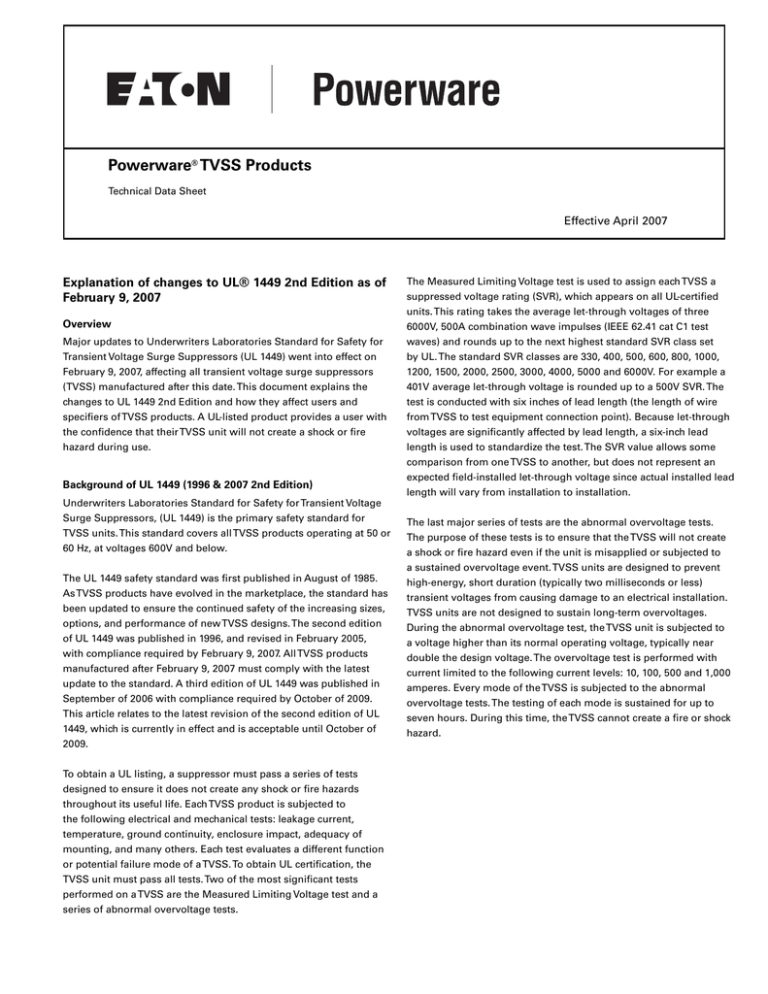
Powerware® TVSS Products
Technical Data Sheet
Effective April 2007
Explanation of changes to UL® 1449 2nd Edition as of
February 9, 2007
Overview
Major updates to Underwriters Laboratories Standard for Safety for
Transient Voltage Surge Suppressors (UL 1449) went into effect on
February 9, 2007, affecting all transient voltage surge suppressors
(TVSS) manufactured after this date. This document explains the
changes to UL 1449 2nd Edition and how they affect users and
specifiers of TVSS products. A UL-listed product provides a user with
the confidence that their TVSS unit will not create a shock or fire
hazard during use.
Background of UL 1449 (1996 & 2007 2nd Edition)
Underwriters Laboratories Standard for Safety for Transient Voltage
Surge Suppressors, (UL 1449) is the primary safety standard for
TVSS units. This standard covers all TVSS products operating at 50 or
60 Hz, at voltages 600V and below.
The UL 1449 safety standard was first published in August of 1985.
As TVSS products have evolved in the marketplace, the standard has
been updated to ensure the continued safety of the increasing sizes,
options, and performance of new TVSS designs. The second edition
of UL 1449 was published in 1996, and revised in February 2005,
with compliance required by February 9, 2007. All TVSS products
manufactured after February 9, 2007 must comply with the latest
update to the standard. A third edition of UL 1449 was published in
September of 2006 with compliance required by October of 2009.
This article relates to the latest revision of the second edition of UL
1449, which is currently in effect and is acceptable until October of
2009.
To obtain a UL listing, a suppressor must pass a series of tests
designed to ensure it does not create any shock or fire hazards
throughout its useful life. Each TVSS product is subjected to
the following electrical and mechanical tests: leakage current,
temperature, ground continuity, enclosure impact, adequacy of
mounting, and many others. Each test evaluates a different function
or potential failure mode of a TVSS. To obtain UL certification, the
TVSS unit must pass all tests. Two of the most significant tests
performed on a TVSS are the Measured Limiting Voltage test and a
series of abnormal overvoltage tests.
The Measured Limiting Voltage test is used to assign each TVSS a
suppressed voltage rating (SVR), which appears on all UL-certified
units. This rating takes the average let-through voltages of three
6000V, 500A combination wave impulses (IEEE 62.41 cat C1 test
waves) and rounds up to the next highest standard SVR class set
by UL. The standard SVR classes are 330, 400, 500, 600, 800, 1000,
1200, 1500, 2000, 2500, 3000, 4000, 5000 and 6000V. For example a
401V average let-through voltage is rounded up to a 500V SVR. The
test is conducted with six inches of lead length (the length of wire
from TVSS to test equipment connection point). Because let-through
voltages are significantly affected by lead length, a six-inch lead
length is used to standardize the test. The SVR value allows some
comparison from one TVSS to another, but does not represent an
expected field-installed let-through voltage since actual installed lead
length will vary from installation to installation.
The last major series of tests are the abnormal overvoltage tests.
The purpose of these tests is to ensure that the TVSS will not create
a shock or fire hazard even if the unit is misapplied or subjected to
a sustained overvoltage event. TVSS units are designed to prevent
high-energy, short duration (typically two milliseconds or less)
transient voltages from causing damage to an electrical installation.
TVSS units are not designed to sustain long-term overvoltages.
During the abnormal overvoltage test, the TVSS unit is subjected to
a voltage higher than its normal operating voltage, typically near
double the design voltage. The overvoltage test is performed with
current limited to the following current levels: 10, 100, 500 and 1,000
amperes. Every mode of the TVSS is subjected to the abnormal
overvoltage tests. The testing of each mode is sustained for up to
seven hours. During this time, the TVSS cannot create a fire or shock
hazard.
Frequently Asked Questions (FAQ)
4. Do the existing TVSS units manufactured or installed before
February 9, 2007 need to be replaced? Are they unsafe?
1. Do Powerware TVSS products meet the updated UL 1449
standard?
No. The changes to UL 1449 represent an enhancement to the
existing standard based on field experience and research. TVSS
units manufactured before February 9, 2007 are still recognized as
acceptable products according to NEC (National Electrical Code)
requirements.
Yes. The PXL and PVL product families have been tested to the updated
standards of UL 1449 2nd Edition, and fully comply with this safety
standard. These product families remain UL 1449 listed.
2. What changes are required to comply to the February 9, 2007
update to UL 1449 2nd Edition?
One of the major safety tests contained in UL 1449 is called the
abnormal overvoltage test. The purpose of this test is to ensure that a
TVSS will not create a shock or fire hazard even when misapplied or
subjected to sustained, long-term, over voltages (i.e. not surge events).
In order to manufacture a UL 1449 listed product after February 9, 2007,
a TVSS product design must have passed four additional sustained
overvoltage tests with currents limited to 10 amperes, 100 amperes,
500 amperes and 1000 amperes. These tests are run for up to seven
hours and to successfully pass the test, the TVSS must not create a fire
or shock hazard during or after the test.
3. Do the changes to UL 1449 2nd Edition February 9, 2007 update
specifically affect the surge suppression performance of the TVSS?
No. In itself, the changes to UL 1449 do not affect or address the surge
suppression performance of the TVSS. Underwriters Laboratories is
an organization that addresses the safety of products, not product
performance.
However, some manufacturers may have modified their products
to meet this updated standard in a way that reduces product life or
performance. For example, if a manufacturer uses abnormally small
fuses or other limited capacity current interrupters to meet the UL 1449
safety standard, the TVSS may open under a relatively small surge
event, providing lower surge suppression capacity.
In considering and evaluating TVSS products it is important to consider
the product performance, specifications and construction along with
the applicable safety standards.
5. Do the updates to UL 1449 2nd edition ban the use of TVSS integrated into distribution equipment such as panelboards, switchboards and MCCs?
No. UL prescribes the results that are acceptable for complying with
standards. UL does not prescribe construction methods or where the
devices can be installed.
It is well established and documented that the best performance of a
TVSS is accomplished by minimizing the lead length connecting the
TVSS to the circuit it is protecting. Integrating TVSS into distribution
equipment achieves the shortest lead length and is the preferred
method of installing TVSS on a new construction project.
6. How can I tell whether a particular manufacturer’s TVSS comply
with the UL 1449 2nd Edition updated standards?
All UL-listed TVSS units must be suitably and plainly marked. These
markings include name of the manufacturer, a distinctive catalog
number, the electrical rating, short circuit current rating (SCCR), SVR,
and the date or period of manufacture. The TVSS must also be marked
with the words “Transient Voltage Surge Suppressor” or “TVSS” and
may additionally be marked immediately following in parentheses with
the words “(Surge Protective Device)” or “(SPD)”.
The best place to get unbiased information is Underwriters
Laboratories (UL) web site, www.ul.com. UL’s online certification
directory (OCD) lists, by manufacturer, which models, kA ratings and
voltages of products are UL listed. The certification category for TVSS is
UL category code “XUHT.” An alternate way to verify a vendor’s listing
is to call UL at 1-847-272-8800.
Primary Contact
TVSS Hotline: 800-809-2772, Option 4 / Sub Option 2
UNITED STATES
8609 Six Forks Road
Raleigh, NC 27615 U.S.A.
Toll Free: 1.800.356.5794
or 919.872.3020
www.powerware.com
CANADA
Ontario: 416.798.0112
Toll Free: 1.800.461.9166
LATIN AMERICA
Argentina: 54.11.4343.6323
Brazil: 55.11.3616.8500
México: 52.55.5488.5252
EUROPE/MIDDLE EAST/AFRICA
Denmark: 45.3686.7910
Finland: 358.94.52.661
France: 33.1.6012.7400
Germany: 49.7841.666.0
Italy: 39.02.66.04.05.40
Norway: 47.23.03.65.50
Sweden: 46.8.598.940.00
United Kingdom: 44.1753.608.700
ASIA PACIFIC
Australia/NZ: 61.2.9693.9366
China: 86.21.6361.5599
HK/Korea/Taiwan: 852.2745.6682
India: 91.11.2649.9414 to 18
Singapore/SEA: 65.6825.1668
Eaton and Powerware are trade names, trademarks, and/or service marks of Eaton Corporation
or its subsidiaries and affiliates.
© 2007 Eaton Corporation
All Rights Reserved
Printed in USA
TVSS12WO
May 2007

